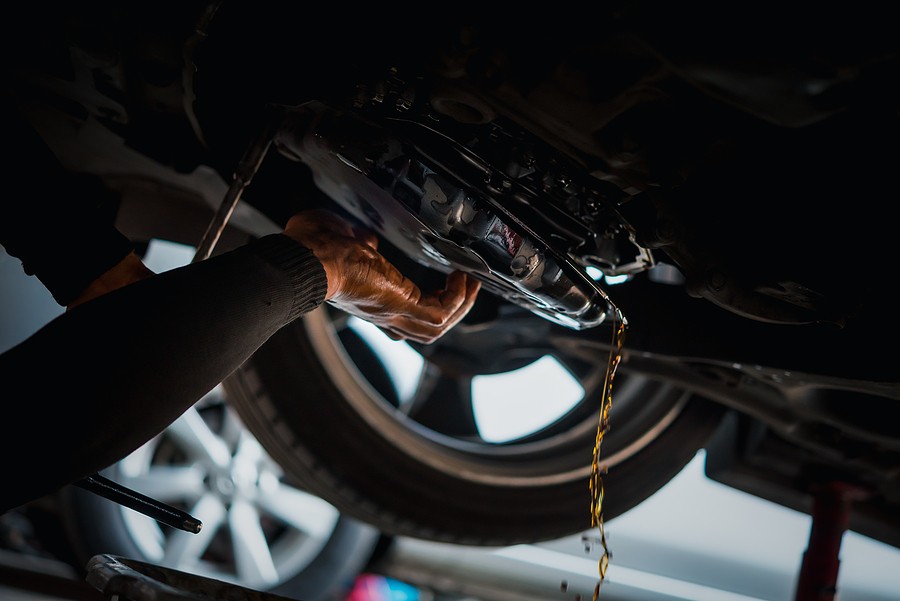Drivers need to know the most common transmission problem symptoms to prevent hefty repair and replacement costs in their vehicle. By being aware of problems in various car categories, such as the engine, transmission, fuel system, electrical components, and the AC/heater, you can prevent these issues from causing irreversible transmission damage.
Noticing differences with the torque converter, transmission solenoids, clutch malfunctions, shifting delays, burnt fluid, slipping transmission, and premature car failure can help you prevent these problems and symptoms from increasing in severity.
Transmission Function
A multi-speed transmission is used in cars and other motor vehicles. This system does not require the driver to change or shift the gears while driving manually. The most common automatic transmission type is a hydraulic automatic, which uses mechanisms like a gearset and torque converter to quickly and efficiently change gears.
The automatic hydraulic system uses various internal clutches and bands to lock certain gears, helping the car determine which gearset is correct for certain conditions. Furthermore, the sprag clutch is used for routine gear shifts and eliminates two clutches’ need to release or apply pressure on differing gear sets. If the driver notices an issue with the internal clutches and bands, they will experience one of the most common transmission problem symptoms.
The gear sets, friction bands, and clutches are controlled by automatic transmission fluid and pressurized pumps to distribute the liquid evenly. If any of these crucial parts go bad during use, you will notice one of the main transmission problem symptoms.
Transmission Fluid Function
The primary function of transmission fluid is to lubricate the different parts of the transmission. However, it also has other important jobs, such as:
- Cleaning and protecting surfaces from excess friction and breakdown
- Conditioning the head gaskets and seals
- Enhancing the coping mechanism to reduce extremely-high operating temperatures
- Increasing rotational speed and temperature range
Transmission Problem Symptoms
-
Torque Converter Malfunction
The torque converter’s main function is to transfer the engine’s power into torque, which is the type of power the transmission can use. Over time, the torque converter will break down and become damaged.
When the converter is functioning correctly, the fluid will flow through the torque converter. However, if it is damaged, the transmission fluid will not flow and cause one of the main transmission problem symptoms.
Fix: Replace the Torque Converter
If you plan to replace the torque converter yourself, you can expect to pay between $150 and $500 for the part. However, if you need a mechanic to do the entire process for you, then expect to spend between $600 and $1,000 to replace the torque converter for your automatic transmission.
-
Solenoid Damage
Along with a worn band and low transmission fluid, there are other reasons for the transmission problem symptoms. The gear changes in the automatic transmission are sparked by the transmission solenoids that convert the automatic transmission fluid into the various components in your transmission to cause things to move and the clutches and bands to disengage from the system.
Fix: Replace the Transmission Solenoids
Depending on what kind of car you drive, like the make, model, and year, you can spend upwards of $400 to replace the entire solenoid pack in your car. Of course, replacing a single solenoid will cost less money, but the problems generally affect more than one solenoid in your transmission system.
You may only have to spend around $250 to replace the solenoid pack in less expensive vehicles. When looking at automatic transmission problems and solutions, repairing or replacing transmission solenoids are some of the easiest and less expensive fixes in your car.
-
Clutch Problems
Both automatic and manual transmission use clutches. Although the clutch issue is more common in manual cars, automatic cars can still succumb to these automatic transmission problems and solutions. These clutch issues can cause one of the most common transmission problem symptoms drivers can experience in their vehicle.
In an automatic car, the transmission and the torque converter have clutch plates that can become worn out and damaged due to insufficient transmission fluid.
Fix: Replace the Clutch
The cost to repair or replace a clutch depends on the damage and severity of the issue, with prices ranging from as little as $500 to as much as $2,500. The overall price depends on the type of car you drive, with luxury and sports cars costing around $2,500 and used cars that are middle-of-the-road costing between $500 and $1,000.
Furthermore, four-wheel-drive cars cost more money when talking about repair prices and the most common transmission problem symptoms.
-
Inability to Stay in Gear
If you find that your car won’t move when you put your car in gear or the gear shifter has trouble moving, this could be an issue with your transmission system. A lack of gear movement is typically attributed to problems with the shifter, the shifter cable, or the valve body.
Fix: Powertrain Control Module Replacement
Replacing your powertrain control module will typically cost between $888 and $963 for this transmission problems cost. The labor costs will range between $79 and $100, while the cost of hte parts is between $807 and $863.
-
Shifting Delay
Other transmission problems and solutions deal with delayed shifting or missing gears. If it takes a long time for your transmission to go into gear, this is typically due to a low level of transmission fluid or fluid contamination. If your fluid is debris-filed or not at the correct level, it can lead to overheating, excess friction, and internal transmission damage.
Fix: Check for Leaks
If you find that you have issues shifting or delays while changing gears, you could be experiencing low fluid levels due to a fluid leak. This issue’s typical transmission problem cost is between $150 and $200 for transmission leak repair.
-
Burnt Fluid
Sometimes, transmission fluid might be burning instead of just being at a low level in your car. If the fluid is not the right color, like black instead of red, or you notice a burning smell, this is likely the culprit. Burnt fluid can occur when the transmission overheats. In this case, you need to swap out your transmission fluid to prevent complications and one of the most common transmission problem symptoms.
Transmission fluid is a crucial component of your vehicle’s internal structures and the performance of your car. The transmission fluid directly affects the transmission, the component uses gears and gear trains to provide the correct amount of speed and torque to the engine from the wheels. If you experience transmission problem symptoms, these components will not be lubricated enough for optimal performance.
Fix: Transmission Fluid Flush
The average cost of a transmission fluid flush will typically cost around $150, with transmission flushes on smaller cars going as low as $100 and bigger trucks costing around $200. If you are unsure how much your specific car will cost, you can expect the flush to cost about double as much as a fluid change.
Fix #2: Check Transmission Fluid Level
- Find the User Manual – First, you need to locate the user manual for your specific car based on your make, model, and year. In the manual, find the recommended procedure for checking your transmission fluid.
- Park the Car – Next, make sure the vehicle is located on a flat surface and is parked. Place the vehicle in the “park” position and ensure that the car will not roll away during use.
- Check Operating Temperature – After this step, make sure you know the engine heat and the overheating potential. Be aware of the cooling fans that will continue running in your internal system after your engine has shut off.
- Turn the Engine Off – Make sure that the engine is off when you check the fluid. Keeping the engine off ensures user safety and can affect the car’s accuracy reading.
- Check the Gears – In addition, some car manufacturers and mechanics recommend moving the gear selector into the different gears for a couple of seconds before checking the transmission fluid levels.
- Find the Dipstick – Regarding the dipstick handle, identify the dipstick using your owner’s manual to locate it within your transmission system. After you have located the dipstick handle, you need to remove the dipstick and clean it using a rag to prevent the transmission problem symptoms.
- Find the Leak – Once the dipstick is removed and cleaned, reinsert the dipstick, remove the dipstick to check the fluid levels, and then identify if you have a leak that needs to be addressed.
-
Worn-Out Gears
The gear set in your vehicle requires various clutches and bands that change the gears and affect the speed changes. The bands in the automatic transmission are usually the key issue when it comes to slipping. The worn-out and damaged band can allow parts of the transmission to continue to rotate for a few seconds after you change gears.
The continuation of the rotation after you change gears causes the gears to feel sloppy, meaning your engine will rev during a gear change and cause one of the most common transmission problem symptoms.
Fix: Replace the Entire Transmission
If your gears are no longer working, unfortunately, you will have to replace the entire transmission. The average price of transmission replacement ranges from $1800 to $3400, with a used transmission being the cheapest option between $800 and $1500. The price of a rebuilt transmission is between $1100 and $2800, and a remanufactured transmission ranges between $1300 and $3400.
-
Slipping Transmission
The slipping transmission is caused by the low transmission fluid, contamination of the transmission fluid, or the lack of routine maintenance in the transmission system. The slipping transmission can also be due to the internal wear and tear on transmission parts inside of the transmission itself. If your engine is also revving highly and slipping transmission, this is one of the most common transmission problem symptoms.
Fix: Check for a Transmission Fluid Leak
If you find that you have issues shifting or delays while changing gears, you could be experiencing low fluid levels due to a fluid leak. This issue’s typical transmission problem cost is between $150 and $200 for transmission leak repair.
-
Grinding When Shifting
One of the main transmission problem symptoms is gears grinding when you try to shift in your car. When your transmission grinds and the shifting gears are not working, this can be a condition that is directly related to the clutch not releasing, the shift synchronizer rings inside the transmission being broken or damaged, or the shifter having an adjustment problem.
In addition, if your transmission fluid and oil are too low, contaminated, full of debris, or is the wrong fluid altogether, this can also cause a severe problem in manual cars.
Fix: Replace Powertrain Control Module
Replacing your powertrain control module will typically cost between $888 and $963 for this transmission problem’s cost. The labor costs will range between $79 and $100, while the cost of hte parts is between $807 and $863.
-
Car Fails Completely
In older cars, adding fresh transmission fluid can cause the car to lose power and fail. Other low transmission fluid symptoms are the car has no power, very little power, and the engine can still run correctly. This problem could form some of the most common transmission problem symptoms, brakes that are not working correctly, or your car’s internal computer having concerns,
Fix: Fix Car’s Internal Computer (Electronic Control Unit)
The parts alone to fix your car’s ECU are between $1,000 and $3,000, which is one of the most expensive repairs and replacements in your vehicle. Depending on the make, model, and year of your car, a faulty ECU might also have to be reprogrammed and repaired.
The Bottom Line
By keeping an eye out for transmission problem symptoms, drivers can prevent the issues from worsening over time and creating irreversible and expensive fixes.



